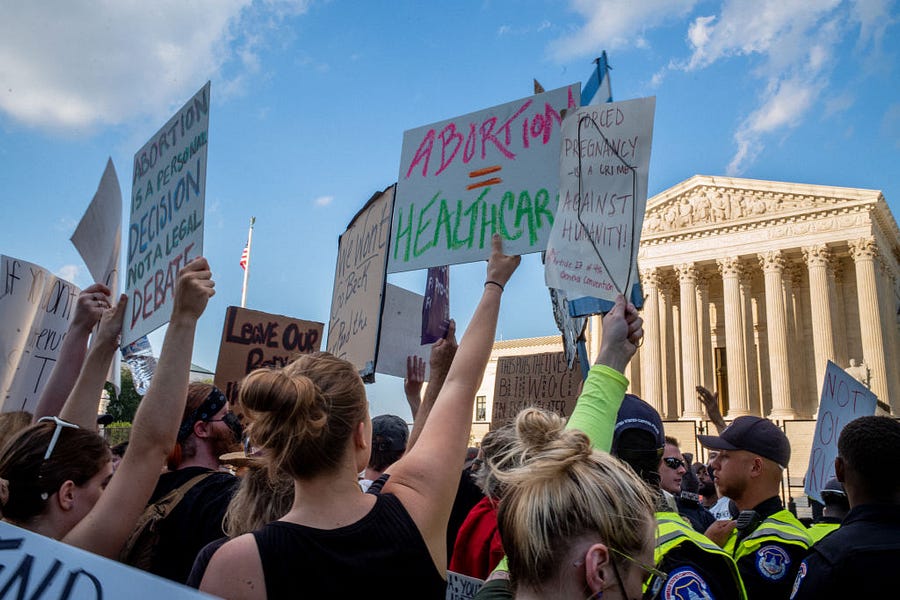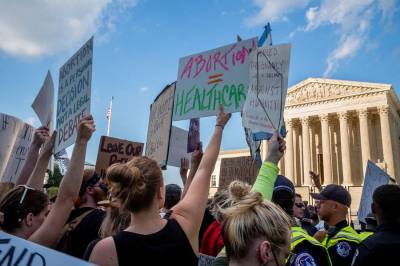Axios was out this week with a new round of stories about why Democrats are confident that the abortion issue will help them this fall, noting that “Democrats see it as a mobilizing issue for suburban women in swing House districts across the country.”
Two polls released in the past 24 hours give Democrats hope the issue will move voters.
• A CBS News/YouGov poll of 1,591 adults found 50% of Democrats were more likely to vote based on the Roe ruling, while only 20% of Republicans said the same.
• In an NPR/PBS NewsHour/Marist poll out this morning (941 adults), 78% of Democrats said the court's decision makes them more likely to vote this fall — 24 points higher than Republicans.
But those polls are meaningful only if the people they are talking to didn’t vote in 2018 or weren’t going to vote this time. And there’s very little evidence for either. I’ve said before I haven’t seen the data to convince me that abortion will affect the midterm election either way. Let me revisit some of those thoughts here:
Large chunks of the Democratic base aren’t aligned with progressives on the issue: From a 2015 poll reported by NBC: “Hispanic millennials hold the most conservative views on abortion among their white, black and Asian counterparts.” And this is from a 2020 Gallup survey: “Black non-Democrats are still less liberal on abortion than are Black Democrats, and in turn, Black Democrats are still less liberal than non-Black Democrats.”
The people most likely to be motivated by this issue are Democrats who most likely voted in 2018 and 2020, meaning there’s no room for growth on an issue that has already sorted people into the partisan camps for the last 20-plus years.
We’ve already tested the hypothesis … twice. First, Terry McAuliffe put abortion front and center in his campaign for Virginia governor in 2021 and lost. But perhaps the reality of overturning Roe wasn’t concrete enough? A month after the Dobbs draft leaked, Democratic primary voters—the most motivated and likely most liberal—voted to keep Henry Cuellar, the last remaining pro-life House Democrat, against his pro-choice challenger. If pro-choice Democrats, can’t turn out enough pro-choice voters in a Democratic primary, it’s hard to make the case that there are enough movable voters in the general election.
On the other hand, there’s a strong argument that increased energy with these Democratic voters will drive small dollar fundraising and increase the number of volunteers who can knock on doors or make phone calls. But that’s a full step removed from increasing turnout or vote share.
I’ve also noted that the exponential growth in money spent on political campaigns has reached the point of diminishing returns—very steep diminishing returns—such that the fundraising bump for Democrats would be meaningful only if they weren’t going to raise sufficient money otherwise. And again, there’s no real evidence for that given the sky-high fundraising numbers from the last few cycles.
But a serious uptick in volunteer (or volunteer-adjacent) numbers would be meaningful. I’m convinced that Democrats can credit their 2021 wins in the Georgia Senate races in large part to their “paid-volunteer” program to motivate low-propensity voters to talk to their networks about voting. Data suggests “their efforts boosted turnout by an estimated 3.8 percent among the 160,000 voters targeted through their relational program.” If Democrats have the funds to repeat that kind of work in 2022—and Dobbs plays a role in getting those quasi-volunteers in the door—then it could have a real impact after all.
Just not the Dobbs-to-vote impact that these polls and news stories are selling.
So What Is Going to Drive More Votes Than Dobbs? This Tweet:
Another Reason Polling is Hard
A great piece by Ariel Edwards-Levy for CNN lays out yet another problem for pollsters heading into the midterms:
In a recent CNN poll, Republicans were 22 points likelier than Democrats to say they’d cut back on driving due to economic conditions, and 25 points likelier to report delays in receiving purchases. In another poll taken this spring, Republicans were more than twice as likely as Democrats to say they'd changed their summer vacation plans due to gas prices, 41% to 16%, dwarfing the divides along other demographic lines. And in a Monmouth University poll released late last year, the share of Republicans saying they found it at least somewhat easy to pay grocery bills plunged 38 points from 2019, while the share of Democrats saying the same rose by 7 points … Polling found Democrats' and Republicans' relative impressions of the economy's strength inverting shortly after the 2020 election.
As Monmouth polling director Patrick Murray wrote, the question for pollsters—even on fact-based questions like how much a person is driving compared to last month—is “whether we are measuring the primacy of partisan identity more than an accurate self-assessment of economic conditions at home.”
This isn’t a new problem, either.
Take an experiment back in 2017 in which participants were shown “side-by-side images of the crowds on the National Mall during the Trump and Obama inaugurations” in which it was obvious that there were more people at the Obama inauguration. Even so, 15 percent of Trump voters “claimed the sparser photograph from the Trump event showed a larger group of people.” Or, to use a less partisan example, the percentage of Americans who told Gallup the economy was good or excellent went up more than 10 points in the immediate aftermath of 9/11 from 32 percent to 46 percent.
There’s two different ways to explain these results. On the one hand, perhaps those Trump voters knew that there were fewer people in the Trump inauguration photo but wanted to show their allegiance to Trump. After 9/11, Americans wanted to project a sense of unity and pride—so they weren’t going to tell a pollster that the economy was mediocre. This is what pollsters call partisan cheerleading in which respondents “use polls as a convenient opportunity to tout their partisan allegiances, rather than a faithful recounting of what they believe to be the truth.”
But the other possibility is that they actually see more people in the Trump photo. Or to use the 9/11 example, more people actually believed the economy was better because their frame of reference of what “good” means had just dramatically changed. Under this theory, “partisan thinking, fueled by polarization and reinforced by partisan divides in news consumption, has fully overtaken the way many Americans perceive their own reality.”
Which is all to say something I’ve been arguing for a long time in this newsletter: Polling results can only tell us the answer, but sometimes it’s hard to know what question they were answering.
‘A Real Sense of Disillusionment’
Republican gains with Latino voters are happening in more places than Texas and Florida.
In Wisconsin, exit polls reported that Trump won 34 percent of the Latino vote in 2016 and 37 percent in 2020. An election-eve poll from the Latino-run firm Latino Decisions also showed a shift in Wisconsin, from 10 percent Latino support for Trump in 2016 to 22 percent in 2020. According to John Johnson, a research fellow at Marquette University, Milwaukee’s heavily Latino South Side moved more toward Trump than any other part of the city. In 2016, Trump won 16.2 percent of the vote in Milwaukee’s majority-Latino wards, and Hillary Clinton won 79.5 percent. In 2020, Trump won 21.8 percent of the vote in those wards, and Joe Biden won 76.6 percent. (Biden won Wisconsin overall, by about 20,000 votes.)
But perhaps the problem isn’t with Latino voters specifically. Harry Enten at CNN flagged a similar trend with Asian American voters, who make up only 4 percent of American voters but are the fastest growing racial or ethnic voting bloc.
Biden won Asian voters by 44 points in 2020, according to Pew data, but “his net approval margin with Asian adults now is 37 points lower than his margin over Republican Donald Trump among Asian voters in 2020.” Generic ballot polling shows Biden down “more than twice as much among Asians than among voters overall.”
And then there’s the recall elections in San Francisco—driven by Asian American voters. And the results in New York mayor’s race:
Democrat Eric Adams easily defeated Republican Curtis Sliwa. His victory margin of 39 points was the same as Democrat Bill de Blasio’s over Republican Nicole Malliotakis in 2017. The heavily Asian precincts (or election districts) in Queens, the most Asian borough in New York, tell a different story. Adams won Queens precincts that are at least 75% Asian by 16 points. De Blasio won those same precincts by 34 points, according to data collected by Matthew Thomas.
That is, the Democratic margin dropped by half from 2017 to 2021.
There is no single reason Democrats are losing altitude with these voters. Democrats strategists are quick to acknowledge the issue but even quicker to explain away the specifics of Texas’ ties to the energy industry or Florida’s Cuban population or Asian parents in San Francisco who didn’t want school admissions policies changed.
But Northwestern professor Geraldo Cadava thinks the problem is bigger as he looks at the Latino vote. These numbers represent “a real sense of disillusionment that many Latino voters feel with the Democratic Party, he writes in The Atlantic. “Democrats shouldn’t assume that they will earn Latino support if their candidates support progressive immigration policies,” Cadava argues, but “must also convince Latinos in Milwaukee and across the United States that Democratic policies on issues including education, the economy, and policing will measurably improve Latinos’ lives.”
And if that sounds a lot like non-Latino American voters to you, then you’ve hit on the biggest problem for the Democratic Party.
If identity politics and intersectionality no longer produce consistent turnout with traditionally Democratic voters, then at some point there will be a seismic shift away from a losing strategy. And that’s not going to be an easy sell with the (disproportionately young, white, college-educated, wealthy) Democratic operatives who are employed to execute—and sincerely believe in—the old “Latinx” strategy.
Meaning we should expect to see Democrats numbers with Latinos and Asian voters continue to drop before there’s enough of a constituency within the Democratic Party to turn the ship around.
Can Incumbent Rep. Michael Guest Hang On in Mississippi?
Audrey has a story on the site today on GOP Rep. Michael Guest of Mississippi, who is struggling to hold onto his seat amid attacks on his voting record ahead of Tuesday’s runoff:
After edging GOP Rep. Michael Guest in Mississippi’s 3rd District Republican primary earlier this month by fewer than 300 votes, Republican congressional candidate Michael Cassidy pivoted his campaign for the runoff ahead.
The former Navy fighter pilot and first-time candidate quietly scrubbed his campaign website of a handful of economic policy proposals that he had originally argued would “incentivize family formation”—a $20,000 stipend to married couples to be paid back upon divorce, a maternity leave program with five years of government benefits, and a $250 monthly stipend to married families with children under age 10 and $500 to those with children ages 10-17 years old. He even walked back his previous support for “allowing all citizens to enroll in Medicare, regardless of age”—shorthand for Medicare for all.
Those proposals are now nowhere to be seen on his campaign platform.
With just hours to go until today’s runoff election, the “American Dream” tab of Cassidy’s campaign site now includes the following disclaimer: “Based on helpful feedback from many conservatives in the 3rd District, I’ve improved my America Dream policies by focusing on lowering the tax burden for working families with children.” In place of his since-deleted policy prescriptions are new proposals aimed at encouraging private businesses to offer maternity leave and expanding the child tax deduction from $3,600 to $10,000 for families not already receiving assistance.
Cassidy has spent his entire campaign claiming that he is running to the right of Guest, whom he frequently calls a “RINO”—short for “Republican in name only.” That contention is now being put to the test in interviews, where he struggles to explain his campaign’s flip-flop on various campaign issues. He becomes particularly defensive when asked about his prior policy commitments to marital stipends and paid maternity leave—policy ideas he says he initially championed because of his desire to confront America’s declining birth rate and “skyrocketing” divorce rate.
“This was something that you know, wasn’t a, this was never part—even though yes, it’s on the website—until Election Day, it was never something that was part of the campaign,” Cassidy, who carried 47.5 percent of the vote to Guest’s 46.9 in the three-candidate June 8 primary, said in an interview with The Dispatch on Friday. (Neither Cassidy nor Guest won the 50 percent vote threshold required to win the primary outright.)
Reports of Cassidy’s 11th-hour platform switch came as welcome campaign fodder for Guest, a two-term incumbent who is now struggling to hold onto his seat more than one year after he joined 34 of his House Republican colleagues in supporting the original independent January 6 Commission. The proposal failed to secure enough support from Republican senators to clear the filibuster. But it still has managed to embattle quite a few Republican incumbents like Guest who are now being accused of having voted for the current House select committee investigating the events of January 6, whose only Republican members are Reps. Liz Cheney of Wyoming and Adam Kinzinger of Illinois.
Tuesday’s runoff pits two factions of the Republican Party against each other in one of the reddest states in the country, with Guest defending the Reagan-era GOP aimed at promoting fiscal restraint, and Cassidy—albeit in a somewhat half-hearted manner—championing an emerging family-oriented economic populism aimed at curbing what he calls the “destruction of the American family.”
There’s more to the story. To read the rest, click here.
To Put on Your Campaign Story Reading List:
“With Swag and Swagger, State Democrats Vie for Front of Presidential Primary Line” by Jonathan Martin in the New York Times
“Can Ron DeSantis Displace Donald Trump as the G.O.P.’s Combatant-in-Chief?” by Dexter Filkins in The New Yorker
“Oz drops Trump branding in general election shift,” by Andrew Solender in Axios
“Liz Cheney Encourages Wyoming Democrats to Change Parties to Vote for Her” by Reid J. Epstein in the New York Times
“Bucking the Party Line on Gun Control” by Audrey Fahlberg








Please note that we at The Dispatch hold ourselves, our work, and our commenters to a higher standard than other places on the internet. We welcome comments that foster genuine debate or discussion—including comments critical of us or our work—but responses that include ad hominem attacks on fellow Dispatch members or are intended to stoke fear and anger may be moderated.
With your membership, you only have the ability to comment on The Morning Dispatch articles. Consider upgrading to join the conversation everywhere.